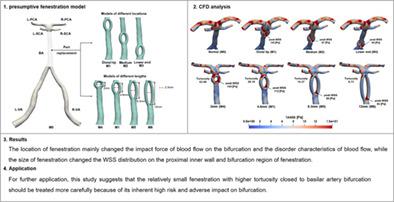当前位置:
X-MOL 学术
›
Int. J. Numer. Method. Biomed. Eng.
›
论文详情
Our official English website, www.x-mol.net, welcomes your
feedback! (Note: you will need to create a separate account there.)
Hemodynamic effects of size and location of basilar artery fenestrations associated to pathological implications
International Journal for Numerical Methods in Biomedical Engineering ( IF 2.2 ) Pub Date : 2021-06-28 , DOI: 10.1002/cnm.3507 Xinyu Tong 1 , Jia Dong 2, 3 , Guojing Zhou 1 , Xuyang Zhang 1 , Ancong Wang 1 , Zhi Ji 4 , Liqun Jiao 2, 3 , Yuqian Mei 1, 5 , Duanduan Chen 1
International Journal for Numerical Methods in Biomedical Engineering ( IF 2.2 ) Pub Date : 2021-06-28 , DOI: 10.1002/cnm.3507 Xinyu Tong 1 , Jia Dong 2, 3 , Guojing Zhou 1 , Xuyang Zhang 1 , Ancong Wang 1 , Zhi Ji 4 , Liqun Jiao 2, 3 , Yuqian Mei 1, 5 , Duanduan Chen 1
Affiliation

|
Fenestration is a rare congenital abnormality that refers to a segmental duplication of arteries. It is still not clear about the role of fenestrations in the etiology and pathological evolution of vascular diseases. This study aims to investigate the hemodynamic influence brought by various sizes and locations of fenestration in basilar artery models. A series presumptive fenestration models were established based on a normal basilar artery model with various sizes and locations. Identical boundary conditions were utilized in the computational fluid dynamics simulations and different flow patterns in the fenestration and bifurcation regions were comprehensively analyzed. Wall shear stress (WSS)-related parameters such as oscillatory shear index (OSI) and aneurysm formation index (AFI) were computed and compared. The value of WSS on fenestration increased by the fenestration's tortuosity, and nearly-circular fenestration suffered higher WSS than narrow-strips one. Also, high OSI and low AFI value mainly occurred in the bifurcation region, indicating a high level of turbulence and high risk of aneurysm formation. The location of fenestration mainly changed the impact force of blood flow on the bifurcation and the disorder characteristics of blood flow, while the size of fenestration changed the WSS distribution on the proximal inner wall and bifurcation region of fenestration. In summary, the nearly-circular fenestration should be stratified carefully which may results in a high risk inducing unfavorable vascular wall remodeling.
中文翻译:

与病理意义相关的基底动脉开窗大小和位置的血流动力学影响
开窗是一种罕见的先天性异常,指的是动脉节段性重复。目前尚不清楚开窗在血管疾病病因和病理演变中的作用。本研究旨在探讨基底动脉模型中不同大小和开窗位置对血流动力学的影响。在不同大小和位置的正常基底动脉模型的基础上,建立了一系列推定开窗模型。在计算流体动力学模拟中使用了相同的边界条件,并综合分析了开窗和分叉区域的不同流动模式。计算并比较了壁剪切应力 (WSS) 相关参数,例如振荡剪切指数 (OSI) 和动脉瘤形成指数 (AFI)。开窗的 WSS 值随开窗的曲折而增加,近圆形开窗比窄条开窗具有更高的 WSS。此外,高 OSI 和低 AFI 值主要发生在分叉区,表明湍流水平高,动脉瘤形成风险高。开窗的位置主要改变了血流对分叉处的冲击力和血流的紊乱特征,开窗的大小改变了开窗近端内壁和分叉区域的WSS分布。总之,近圆形开窗应仔细分层,这可能导致导致不利血管壁重塑的高风险。此外,高 OSI 和低 AFI 值主要发生在分叉区,表明湍流水平高,动脉瘤形成风险高。开窗的位置主要改变了血流对分叉处的冲击力和血流的紊乱特征,开窗的大小改变了开窗近端内壁和分叉区域的WSS分布。总之,近圆形开窗应仔细分层,这可能导致导致不利血管壁重塑的高风险。此外,高 OSI 和低 AFI 值主要发生在分叉区,表明湍流水平高,动脉瘤形成风险高。开窗的位置主要改变了血流对分叉处的冲击力和血流的紊乱特征,开窗的大小改变了开窗近端内壁和分叉区域的WSS分布。总之,近圆形开窗应仔细分层,这可能导致导致不利血管壁重塑的高风险。开窗的位置主要改变了血流对分叉处的冲击力和血流的紊乱特征,开窗的大小改变了开窗近端内壁和分叉区域的WSS分布。总之,近圆形开窗应仔细分层,这可能导致导致不利血管壁重塑的高风险。开窗的位置主要改变了血流对分叉处的冲击力和血流的紊乱特征,开窗的大小改变了开窗近端内壁和分叉区域的WSS分布。总之,近圆形开窗应仔细分层,这可能导致导致不利血管壁重塑的高风险。
更新日期:2021-06-28
中文翻译:

与病理意义相关的基底动脉开窗大小和位置的血流动力学影响
开窗是一种罕见的先天性异常,指的是动脉节段性重复。目前尚不清楚开窗在血管疾病病因和病理演变中的作用。本研究旨在探讨基底动脉模型中不同大小和开窗位置对血流动力学的影响。在不同大小和位置的正常基底动脉模型的基础上,建立了一系列推定开窗模型。在计算流体动力学模拟中使用了相同的边界条件,并综合分析了开窗和分叉区域的不同流动模式。计算并比较了壁剪切应力 (WSS) 相关参数,例如振荡剪切指数 (OSI) 和动脉瘤形成指数 (AFI)。开窗的 WSS 值随开窗的曲折而增加,近圆形开窗比窄条开窗具有更高的 WSS。此外,高 OSI 和低 AFI 值主要发生在分叉区,表明湍流水平高,动脉瘤形成风险高。开窗的位置主要改变了血流对分叉处的冲击力和血流的紊乱特征,开窗的大小改变了开窗近端内壁和分叉区域的WSS分布。总之,近圆形开窗应仔细分层,这可能导致导致不利血管壁重塑的高风险。此外,高 OSI 和低 AFI 值主要发生在分叉区,表明湍流水平高,动脉瘤形成风险高。开窗的位置主要改变了血流对分叉处的冲击力和血流的紊乱特征,开窗的大小改变了开窗近端内壁和分叉区域的WSS分布。总之,近圆形开窗应仔细分层,这可能导致导致不利血管壁重塑的高风险。此外,高 OSI 和低 AFI 值主要发生在分叉区,表明湍流水平高,动脉瘤形成风险高。开窗的位置主要改变了血流对分叉处的冲击力和血流的紊乱特征,开窗的大小改变了开窗近端内壁和分叉区域的WSS分布。总之,近圆形开窗应仔细分层,这可能导致导致不利血管壁重塑的高风险。开窗的位置主要改变了血流对分叉处的冲击力和血流的紊乱特征,开窗的大小改变了开窗近端内壁和分叉区域的WSS分布。总之,近圆形开窗应仔细分层,这可能导致导致不利血管壁重塑的高风险。开窗的位置主要改变了血流对分叉处的冲击力和血流的紊乱特征,开窗的大小改变了开窗近端内壁和分叉区域的WSS分布。总之,近圆形开窗应仔细分层,这可能导致导致不利血管壁重塑的高风险。











































 京公网安备 11010802027423号
京公网安备 11010802027423号